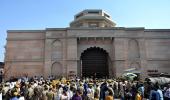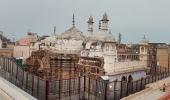Rediff.com's Utkarsh Mishra visits the Kashi Vishwanath temple-Gyanvapi mosque in Varanasi, which is fast being turned into another mandir-masjid dispute.

It was a bright hot day in August, and the clocks were striking thirteen.
If you think that I'm using this corrupted version of the opening line of Eric Arthur Blair's 1984 to begin this feature because I believe that each day we find ourselves a step nearer to the Orwellian dystopia, then you are thinking too much.
It's simply that the clocks were indeed striking 13, okay 13.02 to be precise, when I reached Gyanvapi M... Err sorry, the chief minister of Uttar Pradesh doesn't want it to be called a mosque. So, I will say that the clocks were indeed striking 13 when I reached in front of the sprawling Gate No. 4 of the Kashi Vishwanath temple, behind which I could see the structure which, according to the roadside signage, was the Gyanvapi mosque.
A few years ago, you could not see the mosque from where I was standing. But after the construction of the Kashi Vishwanath corridor, during which the entire area was cleared, it is now fully visible.
Standing here, you're in the heart of Varanasi. As early as the year 1700, the area, as per Professor Madhuri Desai's book Banaras Reconstructed, was already a 'significant urban space and an essential node in a vibrant commercial zone' in the city.

From the vibrant and insanely crowded Godowlia square, you make your way north on a curved, slightly uphill road towards the Kashi Vishwanath-Gyanvapi area. Further ahead is Chowk, where French explorer Jean-Baptiste Tavernier saw 'trading of silk and cotton fabrics between Muslim artisans and Hindu traders', during his visit here between 1660 and 1665.
Three years later, in 1669, Aurangzeb ordered the dismantling of the Vishweshwur, or Vishwanath temple, writes Professor Desai. 'Built on the plinth of the dismantled Vishweshwur temple', the Gyanvapi mosque 'abuts its lone standing wall'.
Originally named the Alamgiri mosque, it subsequently came to be known as the Gyanvapi mosque as it stood next to the sacred Gyan Vapi, or the well of wisdom which, according to ancient texts, is 'said to have been here in Kashi long before the Ganges came to earth'.
In her 1983 book Banaras: The City of Light, Harvard Professor Diana L Eck writes about the famous legend that 'a provident priest' of the Vishwanath temple threw the 'linga of Vishveshvara into the deep waters of' Gyan Vapi, before the temple was 'desecrated by the armies of Aurangzeb'.
Professor Eck also wrote about 'communal clashes' that happened in 1809 when 'Hindus attempted to erect a small shrine on the narrow strip of neutral ground' between the mosque and the temple. Later, citing the 1831 drawing of the area by James Prinsep, she wrote that a platform had been erected for Gyan Vapi 'on that contested ground'.
About the mosque, Prinsep wrote in his Benaras Illustrated that 'it is so close to the well that there might be some fear of serious collision between the zealots of the two religions, were they not effectually checked by a third, ruling and impartial, party'.

Today, this entire area is part of the Kashi Vishwanath temple complex. The mosque is surrounded by iron grills on all sides, and pilgrims entering the temple from Gate No. 4 walk past it to reach the temple.
Earlier, this stretch was simply a narrow lane within surrounding structures, but now it has been widened after the construction of the mega corridor. It has always served as the common entry point of the temple as well as the mosque.
So, I got here with an aim to reach the mosque and talk to a few people there if I could. Since this is the month of Shravan, the sight of saffron-clad kanwariyas is common, alongside the regular rush of pilgrims. Nonetheless, the flow of pilgrims was less than I expected.
As I reached near the gate, enquiring if I could go to the mosque, the security person standing there with a gun told me hitherto shalt thou come, but no further! "Even we can't go," he told me. I asked him if devotees are allowed to offer namaaz in the mosque daily, he replied in the affirmative. But said that it requires one to obtain "permission".
I was coming here for the first time after the construction of the corridor, which has significantly changed the geography of the area that I had in my mind. So, I decided to go inside the temple complex and see if there's a way to go to the mosque. As I entered, I found a staircase which I thought could take me near the mosque. However, it was barricaded and guarded by another security person with a gun.
I enquired if I could go up and see. "No," he said, "not allowed from this side." I tended to insist, but was told that "senior officers would be sitting upstairs and they would first scold you and then me". It was the most polite 'no' I ever had from a man in uniform, so I complied.
Perhaps if it were a Friday, I could have seen Muslim devotees gathering for the afternoon prayers. But on a Wednesday, it was very difficult. I waited outside while herds of temple goers kept coming from the other side.
Devotional music was being played on the loudspeakers placed all along the road. Frequently interrupting it were the announcements by pilgrims looking for their loved ones who got separated from them while getting darshan inside the temple. The different languages in which these announcements were made made it evident that people from every corner of India were here.

Respecting the weather department's 'very heavy rainfall alert', the bright hot day of August soon turned cloudy and it started to drizzle. I sipped tea at a stall right beside the entry gate. The chaiwala said he sees namaazis only on Fridays. "You could see only one or two on other days of the week," he said.
All along the road leading to the gate, there are shops selling prasad, garlands, milk, flowers and other offerings to be made inside the temple. They also serve as lockers where you can deposit your phones and other prohibited items. You walk on this road and they would assume that you are going for a darshan, and pull you inside, while seizing your phone.
One such shopkeeper was amazed when I told him that I want to go to the mosque. "But you can't go there. The matter is in court," he exclaimed, and dissuaded me further.
I walked further towards the Chowk area, where there is a small Muslim shrine. And finally managed to get a Muslim man who was willing to talk to me on the issue.
He told me that prayers are offered daily inside the mosque. When asked if one needs permission to offer namaaz, he said, "No, anybody can go. If anyone is telling you that you can't go, then he's scaring you unnecessarily."
"Well, I tried," I said.
Asked about Chief Minister Yogi Adityanath's remark that 'there will be a dispute if we call Gyanvapi a mosque', and that 'there should be a proposal from the Muslim society' to correct this 'historical mistake', he said, "Who am I to speak for the whole community? It is for the leaders of the community to decide if they want to give up the claim on the mosque or not. But my faith will always be attached to it. How can I let go of my faith?"
He signed off by suggesting that attempts are being made to turn it into a dispute, adding that the issue was not so big, and it will give rise to unnecessary dissension in the society which is not good for the country.









